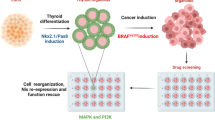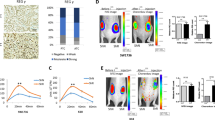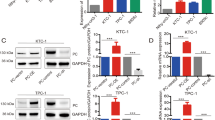Abstract
Cotransfer of thyroid-specific transcription factor (TTF)-1 and Pax-8 gene to tumor cells, resulting in the re-expression of iodide metabolism-associated proteins, such as sodium iodide symporter (NIS), thyroglobulin (Tg), thyroperoxidase (TPO), offers the possibility of radioiodine therapy to non-iodide-concentrating tumor because the expression of iodide metabolism-associated proteins in thyroid are mediated by the thyroid transcription factor TTF-1 and Pax-8. The human TTF-1 and Pax-8 gene were transducted into the human thyroid carcinoma (K1 and F133) cells by the recombinant adenovirus, AdTTF-1 and AdPax-8. Re-expression of NIS mRNA and protein, but not TPO and Tg mRNA and protein, was detected in AdTTF-1-infected F133 cells, following with increasing radioiodine uptake (6.1–7.4 times), scarcely iodide organification and rapid iodide efflux (t1/2≈8-min in vitro, t1/2≈4.7-h in vivo). On contrast, all of the re-expression of NIS, TPO and Tg mRNA and proteins were detected in F133 cells coinfected with AdTTF-1 and AdPax-8. AdTTF-1- and AdPax-8-coinfected K1 and F133 cells could effectively accumulate radioiodine (6.6–7.5 times) and obviously retarded radioiodine retention (t1/2≈25–30-min in vitro, t1/2≈12-h in vivo) (P<0.05). Accordingly, the effect of radioiodine therapy of TTF-1 and Pax-8 cotransducted K1 and F133 cells (21–25% survival rate in vitro) was better than that of TTF-1-transducted cells (40% survival rate in vitro) (P<0.05). These results indicate that single TTF-1 gene transfer may have limited efficacy of radioiodine therapy because of rapid radioiodine efflux. The cotransduction of TTF-1 and Pax-8 gene, with resulting NIS-mediated radioiodine accumulation and TPO and Tg-mediated radioiodine organification and intracellular retention, may lead to effective radioiodine therapy of thyroid carcinoma.
This is a preview of subscription content, access via your institution
Access options
Subscribe to this journal
Receive 12 print issues and online access
$259.00 per year
only $21.58 per issue
Buy this article
- Purchase on Springer Link
- Instant access to full article PDF
Prices may be subject to local taxes which are calculated during checkout








Similar content being viewed by others
References
DeGroot LJ, Kaplan EL, McCormick M, Straus FH . Natural history, treatment, and course of papillary thyroid carcinoma. J Clin Endocrinol Metab 1990; 71: 414–424.
Mitchell PJ, Tjian R . Transcriptional regulations in mammalian cells by sequence-specific DNA binding proteins. Science 1989; 245: 288–292.
Damante G, Di Lauro R . Thyroid-specific gene expression. Biochimica et Biophysica Acta 1994; 1218: 255–266.
Lazzaro D, Price M, de Felice M, Di Lauro R . The transcription factor TTF-1 is expressed at the onset of thyroid and lung morphogenesis and in restricted regions of the foetal brain. Development 1991; 113: 1093–1104.
Plachov D, Chowdhury K, Walther C, Simon D, Guenet JL, Gruss P . Pax8, a murine paired box gene expressed in the developing excretory system and thyroid gland. Development 1990; 110: 643–651.
Di Palma T, Nitsch R, Mascia A, Nitsch L, Di Lauro R, Zannini M . The paired domain-containing factor Pax8 and the homeodomain-containing factor TTF-1 directly interact and synergistically activate transcription. J Biol Chem 2003; 278: 3395–3402.
Zannini M, Francis-Lang H, Plachov D, Di Lauro R . Pax-8, a paired domain-containing protein, binds to a sequence overlapping the recognition site of a homeodomain and activates transcription from two thyroid-specific promoters. Mol Cell Biol 1992; 12: 4230–4241.
Endo T, Kaneshige M, Nakazato M, Ohmori M, Harii N, Onaya T . Thyroid transcription factor-1 activates the promoter activity of rat thyroid Na+/I− symporter gene. Mol Endocrinol 1997; 11: 1747–1755.
Ohno M, Zannini M, Levy O, Carrasco N, di Lauro R . The paired-domain transcription factor Pax8 binds to the upstream enhancer of the rat sodium/iodide symporter gene and participates in both thyroid-specific and cyclic-AMP-dependent transcription. Mol Cell Biol 1999; 19: 2051–2060.
Fabbro D, Di Loreto C, Beltrami CA, Belfiore A, Di Lauro R, Damante G . Expression of thyroid-specific transcription factors TTF-1 and Pax-8 in human thyroid neoplasms. Cancer Res 1994; 54: 4744–4749.
Ros P, Rossi DL, Acebron A, Santisteban P . Thyroid-specific gene expression in the multi-step process of thyroid carcinogenesis. Biochimie 1999; 81: 389–396.
Espinoza CR, Schmitt TL, Loos U . Thyroid transcription factor 1 and Pax8 synergistically activate the promoter of the human thyroglobulin gene. J Mol Endocrinol 2001; 27: 59–67.
Yan C, Naltner A, Chafonkright J, Ghaffari M . Protein-protein interaction of retinoic acid receptor alpha and thyroid transcription factor-1 in respiratory epithelial cells. J Biol Chem 2001; 276: 21686–21691.
Yi M, Tong GX, Murry B, Mendelson CR . Role of CBP/p300 and SRC-1 in transcriptional regulation of the pulmonary surfactant protein-A (SP-A) gene by thyroid transcription factor-1 (TTF-1). J Biol Chem 2002; 277: 2997–3005.
Miccadei S, De Leo R, Zammarchi E, Natali PG, Civitareale D . The synergistic activity of thyroid transcription factor 1 and Pax 8 relies on the promoter/enhancer interplay. Mol Endocrinol 2002; 16: 837–846.
Altmann A, Schulz RB, Glensch G, Eskerski H, Zitzmann S, Eisenhut M et al. Effects of Pax8 and TTF-1 thyroid transcription factor gene transfer in hepatoma cells: imaging of functional protein-protein interaction and iodide uptake. J Nucl Med 2005; 46: 831–839.
Petrich T, Helmeke HJ, Meyer GJ, Knapp WH, Pötter E . Establishment of radioactive astatine and iodine uptake in cancer cell lines expressing the human sodium/iodide symporter. Eur J Nucl Med Mol Imaging 2002; 29: 842–854.
Smit JW, Shröder-van der Elst JP, Karperien M, Que I, van der Pluijm G, Goslings B et al. Reestablishment of in vitro and in vivo iodide uptake by transfection of the human sodium iodide symporter (hNIS) in a hNIS defective human thyroid carcinoma cell line. Thyroid 2000; 10: 939–943.
Mazzaferri EL . Long-term outcome of patients with differentiated thyroid carcinoma: effect of therapy. Endocr Pract 2000; 6: 469–476.
Mandell RB, Mandell LZ, Link Jr CJ . Radioisotope concentrator gene therapy using the sodium/iodide symporter gene. Cancer Res 1999; 59: 661–668.
Shimura H, Haraguchi A, Miyazaki A, Endo T, Onaya T . Iodide uptake and experimental 131I therapy in transplanted undifferentiated thyroid cancer cells expressing the Na+/I− symporter gene. Endocrinology 1997; 138: 4493–4496.
Nakamoto Y, Saga T, Misaki T, Kobayashi H, Sato N, Ishimori T et al. Establishment and characterization of a breast cancer cell line expressing Na+/I− symporters for radioiodide concentrator gene therapy. J Nucl Med 2000; 41: 1898–1904.
Ma XJ, Huang R, Kuang AR . AFP promoter enhancer increased specific expression of the human sodium iodide symporter (hNIS) for targeted radioiodine therapy of hepatocellular carcinoma. Cancer Invest 2009; 27: 673–681.
Huang R, Zhao Z, Ma X, Li S, Gong R, Kuang A . Targeting of tumor radioiodine therapy by expression of the sodium iodide symporter under control of the survivin promoter. Cancer Gene Ther 2011; 18: 144–152.
Spitzweg C, O’Connor MK, Bergert ER, Tindall DJ, Young CY, Morris JC . Treatment of prostate cancer by radioiodine therapy after tissue-specific expression of the sodium iodide symporter. Cancer Res 2000; 60: 6526–6530.
Schipper ML, Weber A, Béh M, Göke R, Joba W, Schmidt H et al. Radioiodide treatment after sodium iodide symporter gene transfer is a highly effective therapy in neuroendocrine tumor cells. Cancer Res 2003; 63: 1333–1338.
Furuya F, Shimura H, Miyazaki A, Taki K, Ohta K, Haraguchi K et al. Adenovirus-mediated transfer of thyroid transcription factor-1 induces radioiodide organification and retention in thyroid cancer cells. Endocrinology 2004; 145: 5397–5405.
Schmitt TL, Espinoza CR, Loos U . Transcriptional regulation of the human sodium/iodide symporter gene by Pax8 and TTF-1. Exp Clin Endocrinol Diabetes 2001; 109: 27–31.
Francis-Lang H, Zannini M, De Felice M, Berlingieri MT, Fusco A, Di Lauro R . Multiple mechanisms of interference between transformation and differentiation in thyroid cells. Mol Cell Biol 1992; 12: 5793–5800.
Maxon HR, Thomas SR, Hertzberg VS, Kereiakes JG, Chen IW, Sperling MI et al. Relation between effective radiation dose and outcome of radioiodine therapy for thyroid cancer. N Engl J Med 1983; 309: 937–941.
Haberkorn U, Kinscherf R, Kissel M, Kübler W, Mahmut M, Sieger S et al. Enhanced iodide transport after transfer of the human sodium iodide symporter gene is associated with lack of retention and low absorbed dose. Gene Ther 2003; 10: 774–780.
Sieger S, Jiang S, Schönsiegel F, Eskerski H, Kübler W, Altmann A et al. Tumor-specific activation of the sodium/iodide symporter gene under control of the glucose transporter gene 1 promoter (GTI-1.3). Eur J Nucl Med Mol Imaging 2003; 30: 748–756.
Nilsson M . Molecular and cellular mechanisms of transepithelial iodide transport in the thyroid. Biofactors 1999; 10: 277–285.
Haberkorn U, Altmann A, Jiang S, Morr I, Mahmut M, Eisenhut M . Iodide uptake in human anaplastic thyroid carcinoma cells after transfer of the human thyroid peroxidase gene. Eur J Nucl Med 2001; 28: 633–638.
Huang M, Batra RK, Kogai T, Lin YQ, Hershman JM, Lichtenstein A et al. Ectopic expression of the thyroperoxidase gene augments radioiodide uptake and retention mediated by the sodium iodide symporter in non–small cell lung cancer. Cancer Gene Ther 2001; 8: 612–618.
Boland A, Magnon C, Filetti S, Bidart JM, Schlumberger M, Yeh P et al. Transposition of the thyroid iodide uptake and organification system in nonthyroid tumor cells by adenoviral vector-mediated gene transfer. Thyroid 2002; 12: 19–26.
Willhauck MJ, Sharif Samani BR, Gildehaus FJ, Wolf I, Senekowitsch-Schmidtke R, Stark HJ et al. Application of 188Re as an alternative radionuclide for treatment of prostate cancer after tumor-specific sodium iodide symporter gene expression. J Clin Endocrinol Metab 2007; 92: 4451–4458.
Dadachova E, Bouzahzah B, Zuckier LS, Pestell RG . Rhenium-188 as an alternative to iodine-131 for treatment of breast tumors expressing the sodium/iodide symporter (NIS). Nucl Med Biol 2002; 29: 13–18.
Shen DH, Marsee DK, Schaap J, Yang W, Cho JY, Hinkle G et al. Effects of dose, intervention time, and radionuclide on sodium iodide symporter (NIS)-targeted radionuclide therapy. Gene Ther 2004; 11: 161–169.
Carlin S, Akabani G, Zalutsky MR . In vitro cytotoxicity of 211At-astatide and 131I-iodide to glioma tumor cells expressing the sodium/iodide symporter. J Nucl Med 2003; 44: 1827–1838.
Gillam MP, Sidhaye AR, Lee EJ, Rutishauser J, Stephan CW, Kopp P . Functional characterization of pendrin in a polarized cell system. Evidence for pendrin-mediated apical iodide efflux. J Biol Chem 2004; 279: 13004–13010.
Rodriguez AM, Perron B, Lacroix L, Caillou B, Leblanc G, Schlumberger M et al. Identification and characterization of a putative human iodide transporter located at the apical membrane of thyrocytes. J Clin Endocrinol Metab 2002; 87: 3500–3503.
van den Hove MF, Croizet-Berger K, Jouret F, Guggino SE, Guggino WB, Devuyst O et al. The loss of the chloride channel, ClC-5, delays apical iodide efflux and induces a euthyroid goiter in the mouse thyroid gland. Endocrinology 2006; 147: 1287–1296.
Paroder V, Spencer SR, Paroder M, Arango D, Schwartz Jr S, Mariadason JM et al. Na(+)/monocarboxylate transport (SMCT) protein expression correlates with survival in colon cancer: molecular characterization of SMCT. Proc Natl Acad Sci USA 2006; 103: 7270–7275.
Acknowledgements
The authors are specially grateful to Dr Ni Chen (Department of Pathology, West China Hospital, Sichuan University, Chengdu, China) for her technical help. This work was supported by Laboratory of Pathology, State Key Laboratory of Biotherapy, West China Hospital, Sichuan University and grant fund of the National Natural Science Foundation of China (no. 81071184) and Sector funds of ministry of health (no. 201002002).
Author information
Authors and Affiliations
Corresponding author
Ethics declarations
Competing interests
The authors declare no conflict of interest.
Rights and permissions
About this article
Cite this article
Mu, D., Huang, R., Li, S. et al. Combining transfer of TTF-1 and Pax-8 gene: a potential strategy to promote radioiodine therapy of thyroid carcinoma. Cancer Gene Ther 19, 402–411 (2012). https://doi.org/10.1038/cgt.2012.13
Received:
Revised:
Accepted:
Published:
Issue Date:
DOI: https://doi.org/10.1038/cgt.2012.13
Keywords
This article is cited by
-
The associations of urinary DEHP metabolite levels, serum thyroid hormones, and thyroid-related genes among the adolescent students from China: a cross-sectional study
Environmental Science and Pollution Research (2022)
-
Modulation of Sodium Iodide Symporter in Thyroid Cancer
Hormones and Cancer (2014)



